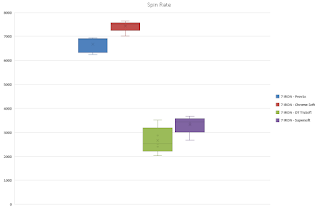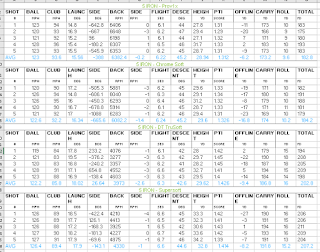I would love somebody to peer review/verify my results...
Having had my Skytrak for a few weeks I have noticed a strange phenomenon when practising at the driving range which I also observed last year on Trackman:
During my Trackman practise I would sometimes observe significant distance differences from one session to another. At the time I thought it might be local weather conditions; a strong headwind reducing distances some days and not others. During each session the wind didnt feel overly strong but distances varied significantly.
My first range session with my skytrak produced a similar distance deviation; I was hitting short-middle irons approx 1-2 clubs longer than normal. When I started looking at the data it became clear the spin rate was significantly lower than expected, not higher as I have typically found with range balls. At the time my teaching pro said it was probably because the balls were wet but I didnt appreciate the difference it made so I set about testing this.
Please see my previous post for the dry ball data here.
Research
This seems to be a poorly studied area with relatively little information available:
http://blog.tourspecgolf.com/wet-versus-dry-golf/
http://www.andrewricegolf.com/andrew-rice-golf/2013/02/wedges-and-water
http://blog.trackmangolf.com/the-difference-in-range-ball-distances/
Hypothesis (largely taken from dry ball testing)
Spin rate will be reduced. Spin rate will be higher with premium balls and lofted clubs.
Distance is largely the same across different ball types but it will be higher when the ball is wet due to reduced spin.
Method
Within the limitations of my indoor setup I tested by capturing 5 solid shots (not blatant mishits) with 4 balls and three clubs. Shots were struck from a soft range mat. Using this mat I have noticed shots launch higher and travel less distance compared to a firmer mat or turf. I dropped each ball into a pot of water prior to hitting.
The 4 balls were:
Titleist Pro V1x
Callaway Chrome Soft
Titleist DT Trusoft
Callaway Supersoft
The clubs were:
PW (46.5°)
7 Iron (33°)
5 Iron (26°)
Results and Analysis
The results shocked me:
A 74% reduction in spin rate between premium and non-premium ball with a PW.
A 21% increase in carry distance (31 yards) between premium and non-premium ball with a 7 iron.
This analysis took several attempts to capture because the quantity of water needed to decimate spin was miniscule. When I first ran the testing I tried to do 1 ball at a time, running dry then wet testing with each ball. I started with 2 premium balls so all was fine and results were inline with expectation. However, I couldn't get dry ball results from the two non-premium balls because there was water on my hitting area (the castoff water) which led to a film of water on the club and low spin flyers. I continued hitting for some time (30-40 shots) but it was never dry enough to replicate proper dry results.
Conclusion
- If you hit the ball reasonably well and play in anything other than a desert use a premium ball. If you dont you risk hitting flyers frequently (even from the fairway).
- A tiny amount of water interacting with a non-premium ball can decimate spin.
- A premium ball is largely immune to this phenomenon; presumably because of the softer cover material which allows the grooves to bite.
- The difference seems greatest with a medium iron.































